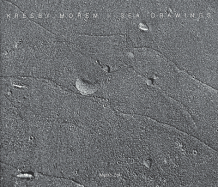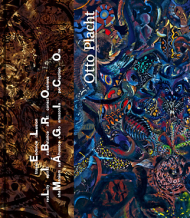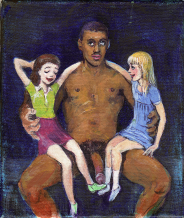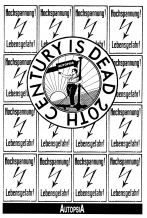| Umělec 1998/5 >> The Disney Syndrome - Orlando, Florida | Просмотр всех номеров | ||||||||||||
|
|||||||||||||
The Disney Syndrome - Orlando, FloridaUmělec 1998/501.05.1998 Tomáš Lahoda | society | en cs |
|||||||||||||
|
"Leisure society is knocking on the door and will not let the travel and entertainment industries sleep. Awakened from their dreaming, they are more than ready to make our dreams come true. The world is dissolving in a vast number of offers that can be connected to directly from your bed using a remote control. It is no surprise that fashion, too, is inspired by colorful, non-wrinkle, loose pajamas. “Just casual“!! Shirts are not large enough and jogging wear is not loose enough. Clothes should not be too tight when one goes for a walk to the unpolluted pedestrian zones.
There were times when kids dressed as adults. Today adults dress as big kids. The consumer/leisure society is interwoven with gradual infantilization and people are slowly becoming confused with comics characters. After all, even respected computer programs make sounds like Donald Duck when one opens them. Gone is the time when world architects snubbed any thought of getting involved with the Disney Corporation’s world of dreams. Today, they are frequent visitors to the company’s director Michael Eisner offices. Eisner, who was hired by one of the best paid industrial tycoons in the USA and is also one of the biggest patrons of art, has doubled the company’s revenues within one decade and expanded its theme parks to numerous countries around the world, all with the help of the greatest names of world architecture. It is clear today that Disneyland is not just a world of dreams, fairy tales and children’s games. Its influence on the adult world is enormous and its reception by the public as the cultural phenomenon of the end of the 20th century cannot go unnoticed. Although it is not a new occurrence, it more effectively influences the architects, designers and artists who seem to be taken aback and unprepared to greet this phenomenon. The ”Disney syndrome” has met with great opposition among experts. Many of them have considered cooperating with such company prostitution. The issue, however, has also attracted architecture theorists, including Europeans, who work with the kitsch phenomenon as with legitimate architectural element. In the 1960‘s, architects Robert Ventaci and Denise Scott Brown were involved with the dream world of Las Vegas and the influence of advertising on our perception of cities, accepting the significance given to symbolic forms. The resulting book Learning from Las Vegas and a provocative article by Charles Moore in Prospecta magazine (1965) stoked up a debate about architecture around the world. In Moore’s essay, he declared Disneyland to be “... the most comprehensive architectural work of the past decades...“ Echoing this opinion is the work by Italian designer Alessandro Mendini who works with kitsch and banal design and unavoidable character of bad taste. He considers architecture to be one great rampant theater in which fantasy and illusion are to be free. For Mendini, Disneyland is a social microspace where art is presented on the same level as consumer goods in supermarkets. Kitsch, banality and humor open people’s eyes for mass consumer goods. Improving quality opens up a road to awareness of commonplace things of everyday life and ultimately to perception of serious art. Mickey Mouse architecture was in the end made official at the Venice Biennale in 1996 when the exhibition committee headed by Austrian architect Hans Hollein accepted the US pavilion’s plan to be devoted solely to Disney architecture. The interesting thing about the Building a Dream exhibition was that the theme and quality of projects was more contemporary and humane than the expensive presentation of architecture of many other countries. From the architectural point of view, Disney is a successor to the Renaissance Mannerist style and displays romantic private gardens with mythical characters, caves, cathedrals, pavilions, streams and fountains of picturesque styles, evoking different moods and states of mind. The aristocratic world of fantasy, further developed by the last century’s great world exhibitions, is now petrified in the entertainment industry’s established institution of theme palaces - which are the monopoly of the Disney corporation. What such theme palaces have in common is that they liberate the visitor from daily problems and offer an escape into the “real“ world of fantasy. The visitor is surrounded by associations of a world long past or wild futuristic visions in a protected, pleasant microspace where he is taken care of and attended to with kindness. It is a world of dreams and fantasy in miniature proportions with the tiniest details in a 5/8 ratio. Shrinking is a classic trick in film since Palladio and Scamozzi who reduced their stage architecture it is applied in stage design. Reducing size is, of course, typical for all toys and models from tiny rooms with dolls to virtual reality games. In all the cases it is about reduced reality. The visitor is separated from his car and, upon entering Disneyland, he becomes a child again drawn into a fairy tale. It is a sort of reconstructed and mummified conglomerate of obsessions and myths, a petrified chimerical fossil of the 19th century fairs which turned into a permanent institution. Almost everything that is typical for Disneyland - and especially for DisneyWorld built in Florida in the 70s - is exactly what constituted world expos. They are separated from the city context as worlds of their own. Traffic is eliminated and replaced with an effective system of various means of “public“ transportation (vans, horse carriages, trams, etc.). Like world expos, theme parks dramatize advanced technologies in connection with presenting distant cultures - both time- and space-wise - in the form of eclectic “national“ pavilions or newly constructed histories of the architecture of all nations, a project which was realized during the world expo in Paris in 1889. When Walt Disney was thinking in Hollywood how to combine a pedestrian paradise with a range of historical city festivals into a permanent leisure time institution, he found a result which is similar to today’s reconstruction of European historic city centers and their transformation into pedestrian zones full of tourists. The real St. Mark’s Square in Venice is not in fact a place where public consumption is any different from the artificial St. Mark’s Square at EPCOT center. The only difference is that the needs of tourists are better met at EPCOT because they are not disturbed by the real life and people who live there. Simulation meets the tourists’ expectations better than the original. Great theme parks built by Disney were created as direct comics series transpositions. Since 1955, when the first Disneyland was opened in Los Angeles, the company has been experiencing a rise in visitors and construction activity. Following DisneyWorld, EPCOT and MGM studios in Florida came the recent EuroDisney in the near vicinity of Paris and the Magic Kingdom replica in Tokyo. These are complete with theme-oriented hotel complexes and office buildings designed by respected architects who are invited to execute a “Disney atmosphere“. Locations where these complexes are built are called “elementary locations“ and, paradoxically, they are typical in lacking any special character to them. Therefore they are multipliable and reproducible anywhere in the world and in space. French philosopher Michel Foucault classifies the Disney parks as places that belong to the category of heterotopia: “places that are out of any place yet they can be easily and exactly localized.“ WDW and Disneyland are considered today models for new planning of American residential areas and public polls show that Mickey Mouse towns are among the most popular places where an ordinary American would like to live. To become an actor in an ideal world that was for the time being lived only in fantasy. The Experimental Prototype Community of the Future was constructed in the 1980s as an ideal of a city. It, however, turned out to be a sort of international showcase of ideas of the future, organized into two thematic units: “The world of the future“ and “Window into the world“. In addition to entertainment, EPCOT also includes scientific and tutorial presentations (Museum of Communication) and some extracts of historic jewelry from various parts of the world. Using the latest technology, the place hyperrealistically reproduces Mayan cathedrals, Chinese pagodas, small medieval German gothic squares, traditional Japanese architecture, streets of Moroccan bazaars, the Eiffel tower and a replica of a Parisian market (which was completely destroyed in Paris) and a cluster of Italian reminiscences with St. Mark’s square, a free interpretation of the Duke Palace in Venice, part of Bernini’s Neptune fountain and reduced Renaissance jewels of Florence. Just off of EPCOT is also the World Sports Complex, the largest and most comprehensive sports complex in the world with adjacent hotels and gigantic sculptures reminiscent of pop-art works by Claes Oldenburg. Huge tennis balls, American football helmets, etc., are scattered on green areas between the low hotel buildings, which feature balconies that look like viewers’ galleries in sports stadiums. This playful pop-culture is also reflected in two of the most architecturally interesting hotels - the Dolphin Hotel and the Swan Hotel by Michael Graves. They are contemporary “Disney“ interpretations of Grand Hotels of the turn of the century, which - in their own way - were exuberant with amazing, beautiful pomp and overdone gems. They, too, were supposed to bring the visitor entertainment and allow him to rise above the routine of everyday life. Desiring to sell unused property (who would buy it so close to a kingdom?) Disney decided to build a real town for 20,000 people close to the Disney Empire in Orlando and try out the principles and methods applied in theme parks. After a long selection process which started in 1988 and included European architects such as Hans Hollein, Rem Koolhas, Aldo Rosi, Bernard Tschumi, Jean Nuvel and Christian de Portzamparc, a group of American architects was picked - Michael Graves, Frank Gehry, Robert Stern, and Antoine Predock, plus a few Europeans, to build the “living“ town of Celebration. Celebration 34747 is designed for undecided middle class people who still remember the life from the time of their grandparents when kids could peacefully play on the streets, when neighbors were friends and part of one friendly community. Disney would like to establish a community of peace, security and stability here, just like in the days when society was not endangered and irritated by the “danger of modernism“. The complete and complex town, with all facilities and necessities of life in them - education, work, entertainment - was all done in Disney style as a state inside a state. The program is not far from the former projects of socialist utopia and totalitarian states. Architecture is just one of the strategies evoking emotive effect. It is not a coincidence that the truly interesting “avant-garde“ projects, such as the fire department (Venturi, Scott Brown), the Disney headquarters (Isozaki) and Team Disney building (Gehry), are mostly inaccessible to the public. The plan of the town itself surrounds the main square with office buildings (Aldo Rosi), banks (Venturi) and a post office (Graves) which link to the tradition of one-story buildings of 19th century American architecture. Next to the post office, Philip Johnson built a town hall with columns which imitates a not very well known project of a festival hall by Heinrich Tessenovuo from Rügen in Germany, 1936. Cesar Pelli, on the other hand, quotes local tradition, and the three-building Preview Center (Johnson, Perlli, Moore and Anderson) is excellent in its vocabulary. The rest of the buildings, particularly the town plan, follow the romantic idea of an idyllic town of the 19th century. This is reflected in Celebration’s logo: a woman with a ponytail riding a bike with a little dog following her, all under the shadow of an apple tree behind a wooden fence. The main street is built in classic revival mixed with Caribbean colonial style. The ground floor includes shops and on the first floor are apartments and small attorneys’ offices. Cars are parked in the backyard. There are no underground parking spaces, the center of town is grouped around a port on a little lake with restaurants and amusement outlets. There are four types of homes in the town: Estate Lots - the largest prestigious villas with adjacent apartments for servants, Village Lots - similar to expensive European villas, Cottage Lots - modest family homes, and Townhouse Lots - economy homes. All of the types are available in six variations of style: classical, Victorian, colonial, revival, seaside, Mediterranean and French. Hidden behind the romantic “historical“ facades, however, are high-tech networks connected to the Internet and electronically controlled security systems. Each house is actually a fully electronically controlled multimedia interactive facility equipped with the latest technology. The concept of the theme park in Japan is considered a western phenomenon inspired by Disneyland and its name employs a different lettering style - KATAKANA – like other imported English and French words. In this way, its “otherness“ is emphasized and is immediately visible.During the 80s economic boom in Japan, there was a tendency to consume anything imported: beer, cars, writers, trends. Imported architecture was a part of the whole package of appropriation and imitation of the west. The Japanese relationship to European architecture has a certain erotic twist to it - numerous “love hotels“ evoke historical palaces and castles, such as the Neuschwannnstein castle, with their bizarre pseudo-romantic styles. New projects of imported architecture are being separated from the image of the street as “other“ as well, significant for imported ideas and skills. Two examples: the Asahi Beer Hall by Phillip Starck in Asakusa and the Wall Project by Nigel Coats in Roppongi. Construction of the remarkable Huis den Bosch at the southernmost part of the Kyushu Island gave birth to building entire complexes “from other places“, a sort of virtual tourism: consumption of foreign architecture on local soil. Huis den Bosch is not only a reconstructed part of a Dutch town, it is also a large recreational spot with 58 restaurants, 14 museums, 67 stores, laser shows and fireworks. It includes the Hotel Europe, built after the Amsterdam Hotel de l’Europe which is, however, built on a much larger scale with the interior designed by a Dutch designer. The irony of it is that thanks to Huis den Bosch, there exists a precise record of traditional Dutch architecture that may remain untouched by time. The current examples from Holland that served as examples for Huis den Bosch go through constant changes due to their use by the Dutch, who apply new construction materials for the contemporary purposes of the buildings. In contrast to the plastic replicas in American theme parks, the Japanese pay a great deal of attention to authentic construction techniques and materials while they reconstruct imported buildings.In March 1997, Shakespeare Country Park was opened in Chiba County. They built various types of buildings from that time: a farm, a townhouse, a pub and a theater. The project’s architect, Julian Bicknell, writes about the park: “it would be expected in Europe that a theme park becomes an exercise in cynical opportunism and commercial blackmail of the romanticizing version of Stratford-upon-Avon, or worse a caricature of comics series of the Disney style. In Japan, the expectations and the final product are completely different. Shakespeare Country Park fits in the Japanese tradition of recreational pilgrimage centers. Surprisingly, every school child knows the name of Shakespeare (who in Europe hears of Chikamatsuo or other known Japanese poets or writers?). The Japanese are not disappointed that they cannot see the original; their approach to building such parks is in many ways similar to their reconstruction of shintoist temples, which takes place every 20 years: taken apart and built from new materials. It is an authentic practice that has been going on for centuries. What is celebrated here is not the age of the buildings but the importance of the place and authenticity and skill of the ritualized reconstructions. The aesthetics of theme parks in Japan is in accordance with the current consumer trend yuttari, meaning easy, pleasant, calm. Commodified cultural artifacts are recontextualized in Japanese style both in Tokyo’s Disneyland and in Kashiwazaki Turkish Culture Village. Turkish Airlines sponsored the construction of various models of Turkish culture, including a bazaar full of goods from Istanbul, a Turkish restaurant, a gallery of contemporary Turkish art and a square with Turkish dance performances. It is not clear whether this is an attempt by Turkish Airlines to attract the Japanese to visit the real country of Turkey or whether it is a recognition of the understanding that what tourists want today is a planned series of the selected highlights of a foreign culture gathered in a well-structured place, in replacement of the “real thing“. For many, there may be no difference. In his book Life After God, Douglas Coupland calls the contemporary generation the first generation that grew up without any religion. Characteristic of this “generation after God“ is its sensuous perception of reality. Knowledge is not based on any structural understanding of the world, history and culture. It is based on the resonance of the experiences of taste, touch, smell and sound. Facing the great confusion and complexity of the world, a tendency to sensuous perception of the world is ever expanding - everything is to be tasted, things are shaken with to find out what sound they make, or hit to find out their resistance. This “physical“ level of approach to the world is reflected in “design after God“, with the increasing use of plastic, imitating colorful, elastic, semitransparent jelly. Exemplifying this aesthetic category are designs by Philipp Starck and the King Kong group (Stefano Giovanni and Guido Venturini), who produce pleasant high-touch objects. The latest demonstrators of this idea include the Dutch group Droog Design, whose members taste and bite their products, put their fingers in their noses, ears and belly-buttons…while the Landesmuzeum in Linz, Austria, collects objects according to their sensuous correspondence. In which category would this museum place traditional Japanese superrealistic replicas of “bento“ food made from artificial, jelly-like matter, which may be spotted in the windows of any Japanese restaurant? "
01.05.1998
Рекомендуемые статьи
|
|||||||||||||
|
04.02.2020 10:17
Letošní 50. ročník Art Basel přilákal celkem 93 000 návštěvníků a sběratelů z 80 zemí světa. 290 prémiových galerií představilo umělecká díla od počátku 20. století až po současnost. Hlavní sektor přehlídky, tradičně v prvním patře výstavního prostoru, představil 232 předních galerií z celého světa nabízející umění nejvyšší kvality. Veletrh ukázal vzestupný trend prodeje prostřednictvím galerií jak soukromým sbírkám, tak i institucím. Kromě hlavního veletrhu stály za návštěvu i ty přidružené: Volta, Liste a Photo Basel, k tomu doprovodné programy a výstavy v místních institucích, které kvalitou daleko přesahují hranice města tj. Kunsthalle Basel, Kunstmuseum, Tinguely muzeum nebo Fondation Beyeler.
|







































 New book by I.M.Jirous in English at our online bookshop.
New book by I.M.Jirous in English at our online bookshop.
Комментарии
Статья не была прокомментированаДобавить новый комментарий